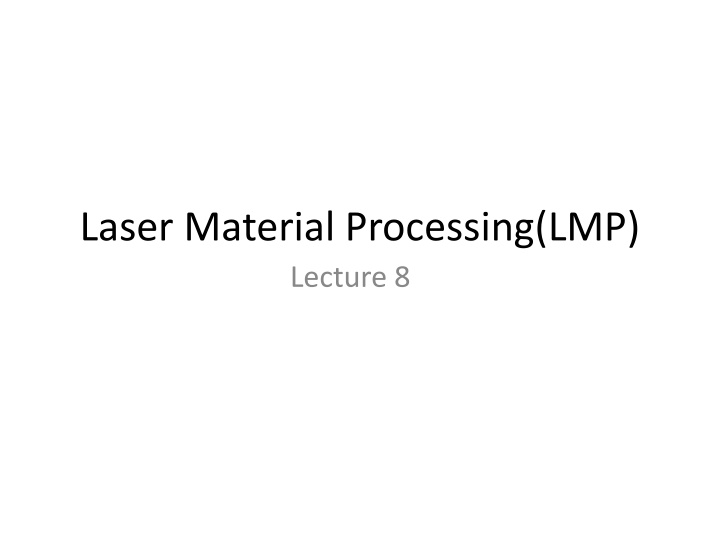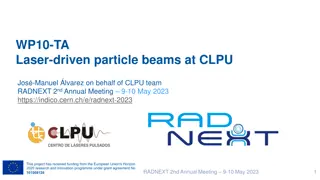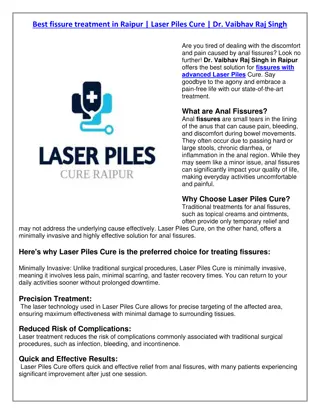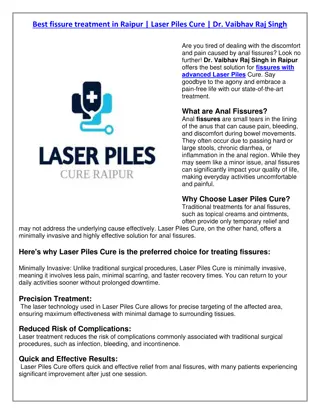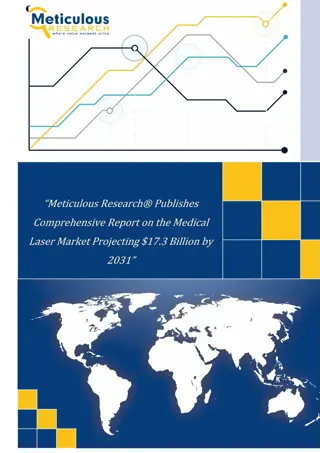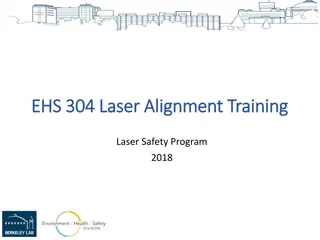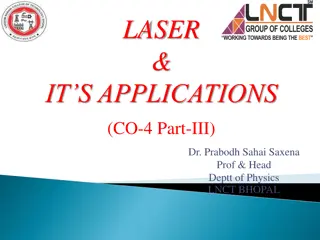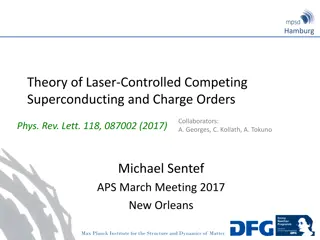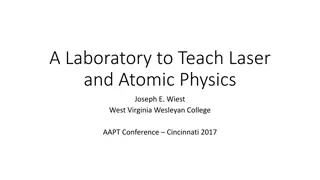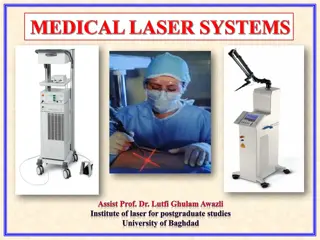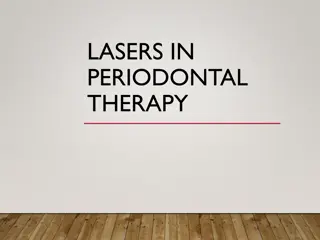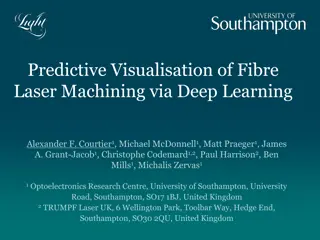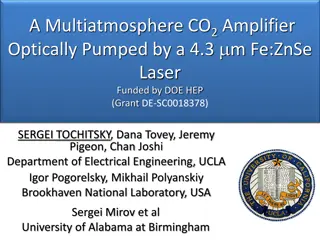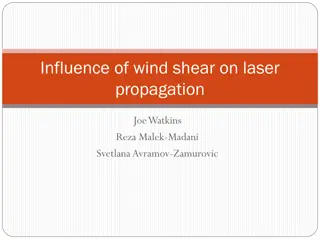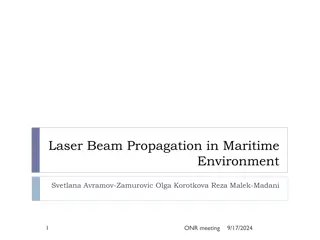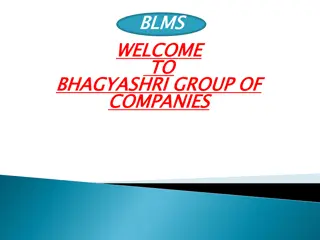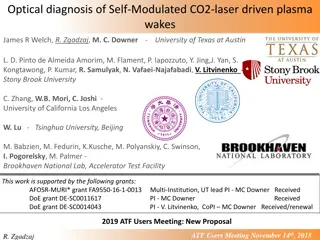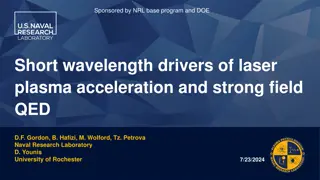Laser Material Processing(LMP)
Laser material processing and joining play a crucial role in industries like automotive and aerospace, enabling clean and precise welding of various materials. This includes using CO2 and Nd:YAG lasers for welding steel, nonferrous metals, ceramics, and plastics. The process involves creating weld joint configurations like butt welds, lap welds, and edge flange welds, with distinct metallurgical aspects affecting base metal, fusion zone, heat-affected zone, and partially melted zone.
Download Presentation

Please find below an Image/Link to download the presentation.
The content on the website is provided AS IS for your information and personal use only. It may not be sold, licensed, or shared on other websites without obtaining consent from the author.If you encounter any issues during the download, it is possible that the publisher has removed the file from their server.
You are allowed to download the files provided on this website for personal or commercial use, subject to the condition that they are used lawfully. All files are the property of their respective owners.
The content on the website is provided AS IS for your information and personal use only. It may not be sold, licensed, or shared on other websites without obtaining consent from the author.
E N D
Presentation Transcript
Laser Material Processing(LMP) Lecture 8
Laser Joining -See this video https://www.youtube.com/watch?v=rIqRnNiprYA Figure . Diamond welded on steel for grinding instruments. Figure . Laser welding of electronic microcomponents.Figure . Welding cord by continue welding
Laser Joining -One of the earliest and most widely practiced applications of laser material processing was joining of metallic sheets using laser . -Today, the automobile and aerospace industry relies on lasers for a clean and non-contact source of heating and fusion for joining of sheets. -Laser joining is applicable to inorganic/organic and similar/dissimilar materials with an extremely high precision, versatility and productivity that can only be matched by electron beam welding. -Laser joining encompasses welding, brazing, soldering and even, micro welding, etc.
Lasers Used For Welding -The most common form of lasers used for welding are: - CO2 laser (10.6 um) wavelength and - Nd:YAGlaser laser(1.06 um) wavelength . -Materials To Weld By Laser 1- Steels 2- Nonferrous metals. 3- Ceramic materials 4- Dissimilar materials. 5- Plastics materials
Laser Joining -Fig. bellow shows the set-up for laser welding. -The focused laser beam is irradiated to the target. -Argon protection gas from oxidation is provided to the weld pool. -Laser heating fuses the work pieces joins them.
Weld Joint Configurations -As shown in fig. 3, there are four main weld joint configurations: - Butt weld -Fillet lap weld - Overlap weld -Edge flange weld
Metallurgical Aspects of Laser Welding -Laser welding is a fusion process, where material is heated, melted, and solidifies. The parts are joined by melting the interface between them and allowing it to solidify However laser welding processes, yields three major distinct regions see Fig.: -The base metal which is material that has not been altered by the welding process; -The fusion zone (weld pool) , composed of material, that is melted during welding; and -The heat affected zone (HAZ), composed of base metal, that has been changed in some measurable way by welding -The partially melted zone which is a zone that is partially melted, during processing in the region closest to the fusion boundary (between F.Z and HAZ),
Laser Joining Classification -1.Laser Soldering and Brazing -In the laser soldering and brazing processes, the beam is used to melt a filler addition, which wets the edges of the joint without melting the base material. -Laser soldering started to gain popularity in the early 1980s for joining the leads of electronic components through holes in printed circuit boards.
Laser Joining Classification -2.Laser Welding: -The weld is formed as the intense laser light rapidly heats and melts the base material-typically calculated in milli- seconds. -There are typically three types of welds according to weld depth (penetration): 1.Conduction mode. 2.Conduction/penetration mode. 3.Penetration or keyhole mode.
Laser Joining Classification 1.Conduction mode. -In conduction welding the laser beam intensity is insufficient (I < 106 W/cm2 ) to cause materials vaporization, but enough to cause local melting.-Thus the weld nugget is shallow and wide with a low aspect ratio (weld depth/weld width), which is often required when limited penetration in the thickness direction is desired. Filler material cannot normally be used in Conduction welding .Conduction mode is possible in spot welding . Figure .The shape of the weld pool in conduction mode.
Laser Welding Types 2.Conduction/penetration mode. -The transition from the conduction mode to that in which a keyhole is formed leads to form this type of welding. -Its characteristics depends on the peak laser intensity and duration of the laser pulse applied to the work piece .
Laser Welding Types 3.Penetration or keyhole mode. -In this mode of laser operation , intensity lie between 106 and 5 107 W.cm- 2where the laser intensity must be high enough to heat , melt and vaporize the front material. -The diameter of the keyhole is approximately that of the beam diameter. ----- -High aspect ratio (weld depth/weld width), is achieved with keyhole welding mode Fig. The shape of the weld pool in keyhole mode
Laser Welding Types -In keyhole mode energy is absorbed by the material through two mechanisms ,that determine the overall energy transfer efficiency: -1.Inverse Bremsstrahlung absorption (transfer of energy from photons to electrons), takes place in the partial ionized plasma formed in and above the keyhole , it is the keyhole absorption mechanism, that dominated at low welding speeds. -2. Fresnel absorption by multiple reflections at the walls of the keyhole dominates at high welding speeds. -Keyhole welding is efficient because the vapor channel traps the laser beam , reducing loss of energy by reflection , and because the keyhole acts as a cylindrical heat source extending below the surface of the work piece, reducing loss of energy by thermal conduction out of the fusion zone
Laser Transmission Joining(LTJ) -Despite the lack of laser direct joining between transparent polymers TP (Transparent material to laser light) and metals in industrial applications, several years ago few researches prove that such joining is possible. -LTJ between TP and metals can be carried out by placing the two parts in a direct contact lap configuration under suitable pressure, as light passes through TP, hits and heats the metal surface at the interface to a temperature above the TP melting point Fig. below.
Laser Transmission Joining(LTJ) -The generated heat (due to the interaction between light and metal) transfers towards the TP side causing polymer heating and melting. -The molten polymer moist the metal surface over the hot zones (interaction zone and HAZ) and joining toke place during cooling -LTJ leads to conduction mode
Laser Welding Efficiency -Welding efficiency can be defined as a power transfer coefficient ( ) which the ratio between laser power absorbed by the work piece and incident laser power. =Pab./Pinc. -At the beginning of welding the ratio is usually very small but can approach unity once a keyhole has been established. -The Welding efficiency ( ) is given by, = [v d W Hm / Pinc.] - where v is welding speed, d is sheet thickness, W is beam width and Hm is the heat content of the metal at the melt temperature. The maximum value of ( ) is 0.48 for penetration welds and 0.37 for conduction welds.
The Quality And Properties Of Laser Weld -The quality and properties of laser weld depend on: - laser pulse time - laser power density, - laser spot diameter/penetration, - melt area, - melting ratio and - material properties like absorptivity, specific heat, density, etc.
Laser Welding Applications -It can be seen from these tables that the laser has something special to offer as a high speed, high-quality welding tool. -One of the larger welding applications at present is that of tailored blank welding for the car industry
Laser Welding Applications https://www.yout ube.com/watch?v =rsTBPh2vKL4
Advantages of Laser welding 1. High depth-to-width ratio, ranging from 3:1 to 10:1. 2. Low and highly localized total heat input that results in minimal distortion and small heat- affected zone size. 3. Noncontact processing. 4. The beam is not require a vacuum for welding as in electron beam welding 5. Easier access to the weld region since the beam can be easily directed to target. In this regard, Nd:YAG lasers are more flexible than CO2 lasers since Nd:YAG lasers are more easily delivered to the workpiece using fiber optic cables. 6. Ability to weld dissimilar materials since the heat input is limited to a very small region. 7. Ability to control the power density by focusing. 8. Easily automated process. 9. Relatively faster than most conventional welding processes. 10. Relatively high weld strength
Disadvantages of laser welding 1. High cooling rates. The low energy input results in high cooling rates that may produce hardening in the weld bead and also in portions of the heat affected zone. This is especially true of high-hardenability materials such as high carbon and some alloy steels. The formation of such undesirable microstructures is normally mitigated by either preheating before welding or post weld heat treatment. 2. High transverse temperature gradients that may result in microcracking. 3. Need for precise fitting of joints. The small size of the heat source and resulting molten pool require closely and accurately fitted joints, especially in the case of butt welding since any significant opening will result in a void, undercut, or power loss through the opening. 4. High initial capital investment cost of the laser.
Governing Factors For Material Processing -All LMP engineers use the Figure below to select the range of Governing Factors [laser power density (Y-axis , and deposition time X- axis)for certain process surface hardening, melting, welding, cladding , drilling, cutting, etc.].
Governing Factors For Material Processing -Home Work Use the previous Figure to select the range of Governing Factors [laser power density (Y-axis , and deposition time X-axis)for the following LMP: 1.Conduction Welding mode 2.Deep Penetration Welding mode
